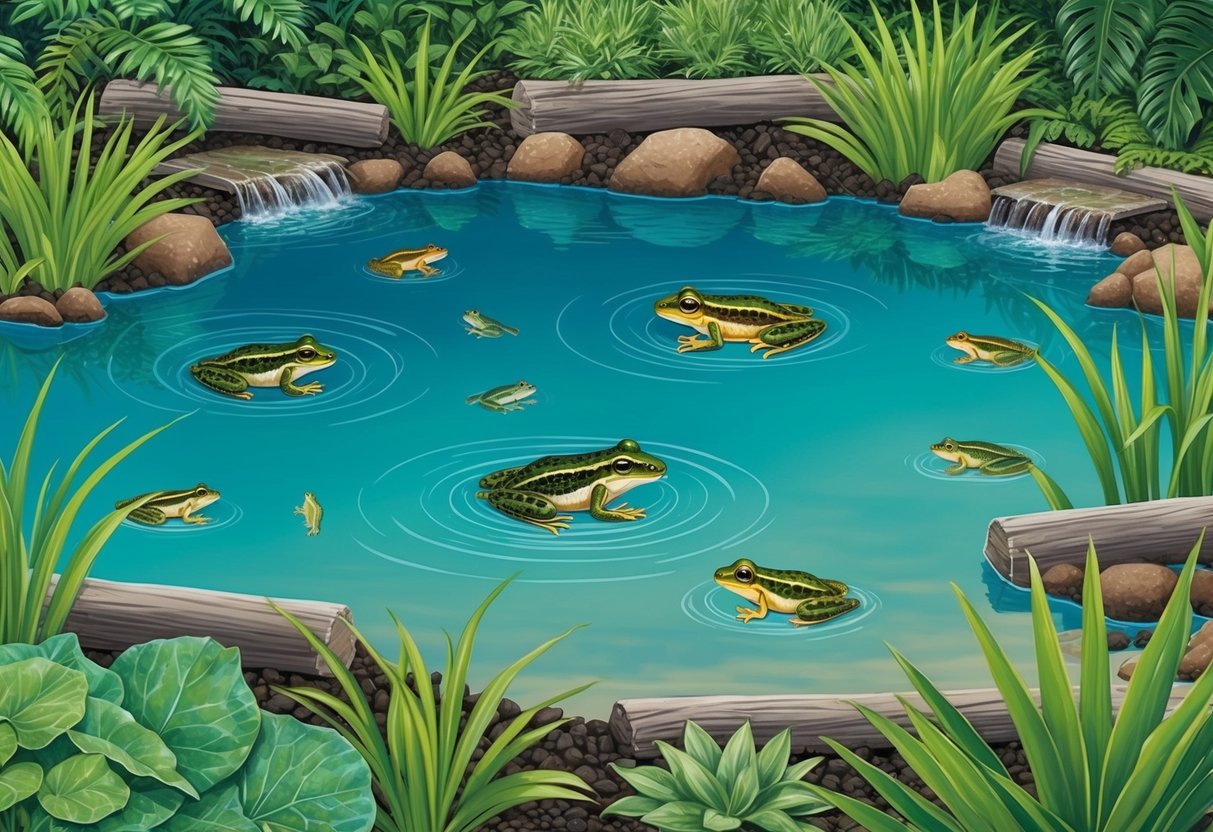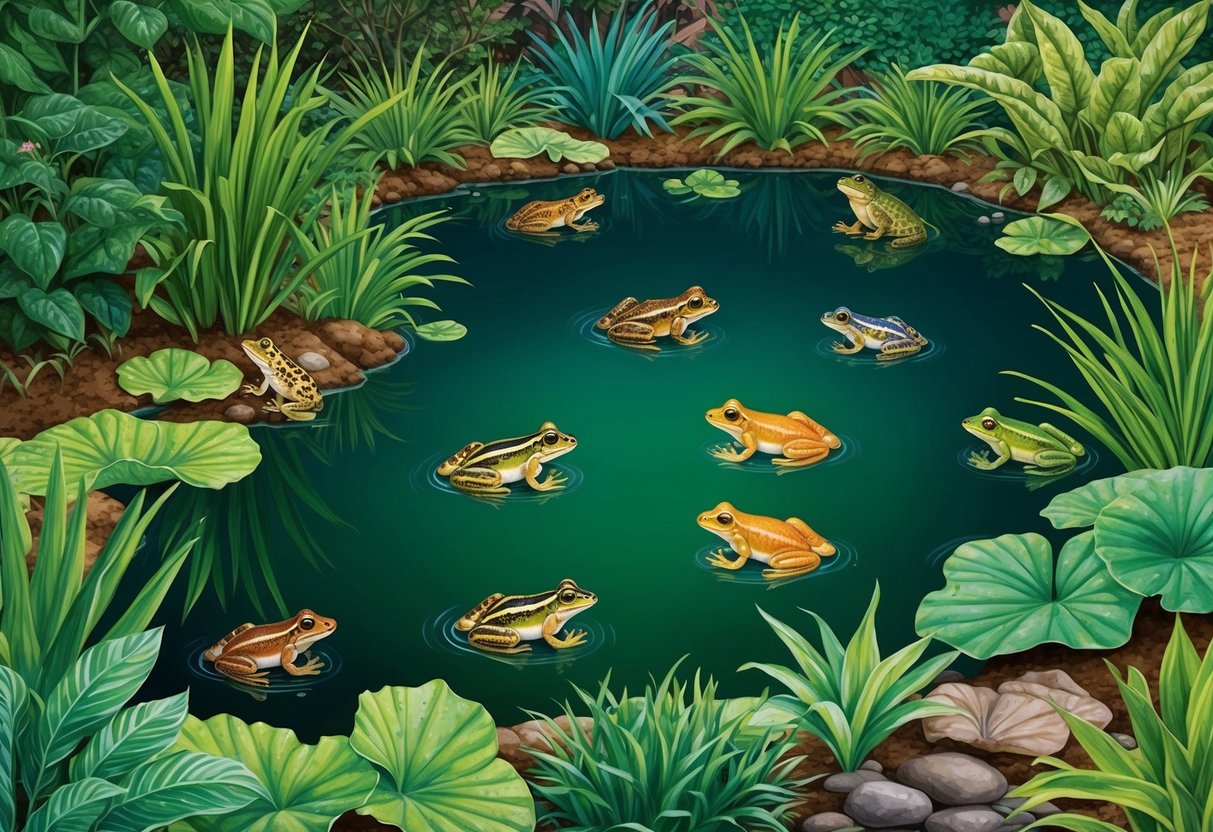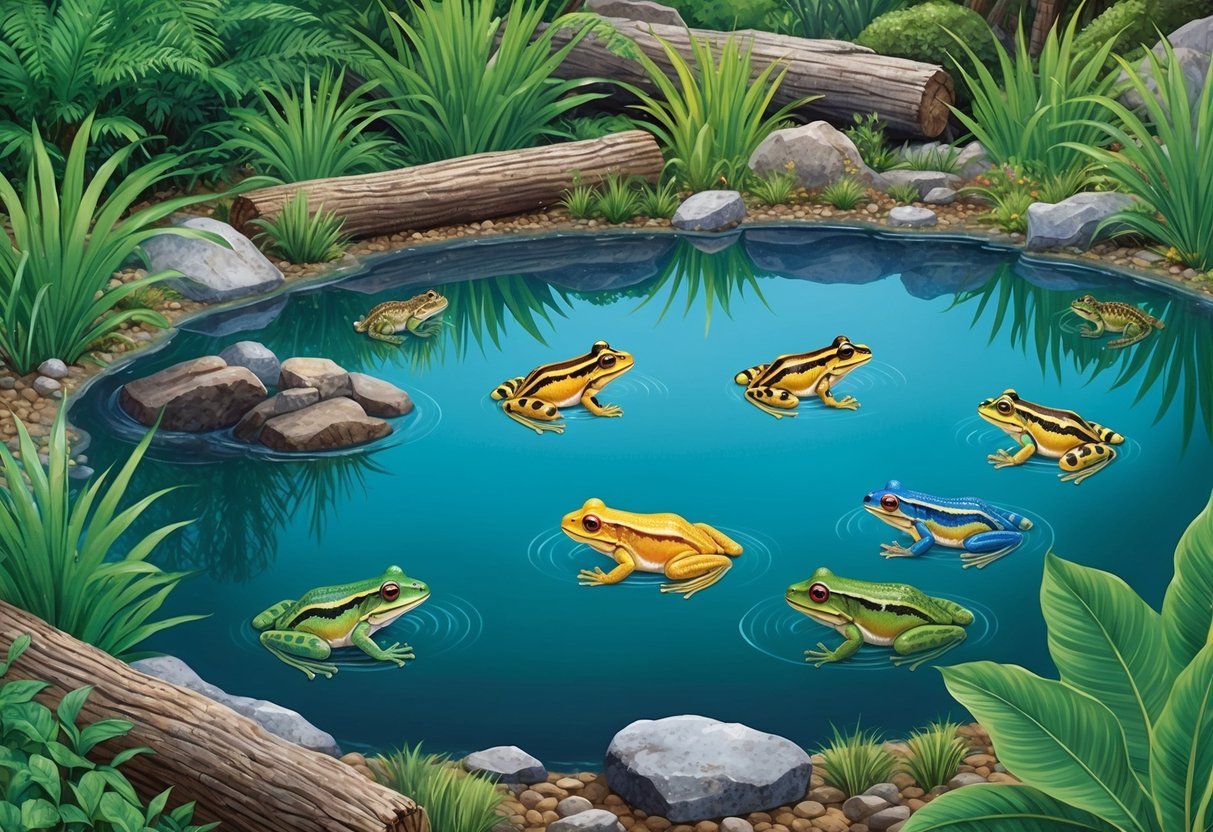How To Attract Native Frog Species To Your Pond: Simple Steps for a Croaking Paradise
Frogs are fun and helpful creatures to have in your garden pond. They eat bugs and make cool sounds at night.
If you want to bring frogs to your pond, you need to make it a nice home for them.
To attract native frogs to your pond, create a habitat with shallow edges, lots of plants, and clean water.

You can make your pond frog-friendly by adding the right plants. Water lilies and other floating plants give frogs places to hide and rest. These plants also help keep the water clean.
Frogs like ponds with both wet and dry areas nearby. This lets them move between water and land easily.
It’s best to focus on frogs that already live in your area. Different types of frogs like different things.
You can learn about the frogs in your region and what they need. This will help you make the perfect frog home in your backyard.
Understanding Your Local Frog Species

Knowing your local frog species is key to creating a frog-friendly pond. Learn how to spot native frogs, what they need to thrive, and how their habits change with the seasons.
Identifying Native Frogs
To attract native frogs, you first need to know which species live in your area. Look for frogs that are natural to your region. You can find this info from local wildlife guides or nature centers.
Pay attention to:
- Size
- Color patterns
- Call sounds
Take photos if you see frogs nearby. Compare them to field guides or ask experts to help ID them.
Don’t try to bring in non-native frogs. They may not survive or could harm local ecosystems.
Habitat Preferences
Different frog species like different homes. Some prefer still water, others like streams.
To make your pond perfect for local frogs:
- Add native plants they’re used to
- Create shallow areas and deeper spots
- Put in rocks and logs for hiding and sunning
Frogs need places to:
- Hide from predators
- Lay eggs
- Find food (like insects)
Make sure your pond has clean water. Use a non-toxic liner to keep water levels steady.
Seasonal Behaviors
Frogs change what they do as seasons change. In spring, they breed. Summer is for eating and growing. Fall is prep for winter.
For spring, set up breeding areas in your pond and keep water levels steady.
In summer, provide shady spots to cool off and keep insects around for food.
For fall, add leaf litter for winter homes and create deep areas that won’t freeze.
In winter, don’t disturb the pond, and remember that some frogs hibernate underwater.
Designing Your Pond for Frogs
Creating a frog-friendly pond involves careful planning and design. A well-designed pond will provide frogs with the perfect habitat to thrive and breed.
Size and Depth Considerations
Your pond’s size and depth play a big role in attracting frogs. Aim for a pond that’s at least 6 feet wide and 2 feet deep. This gives frogs enough space to swim and dive.
Sloped sides are important for easy access. Frogs need to enter and exit the water easily. Make sure one side of your pond has a gentle slope.
Include shallow areas too. These warm up quickly and are great for tadpoles. A mix of depths creates different temperature zones, which frogs love.
Remember, bigger isn’t always better. Even a small pond can attract frogs if designed well.
Shelter and Breeding Areas
Frogs need places to hide and lay eggs. Add lots of plants around the edges of your pond. This gives frogs cover from predators.
Floating plants are great for shelter. They provide shade and a place for frogs to rest. Try adding water lilies or duckweed.
Place rocks and logs near the water’s edge. Frogs can bask on these to warm up. They also offer protection from the sun.
Create shallow, plant-filled areas for breeding. Frogs often lay eggs in these spots. Make sure these areas are easy to access from the water.
Water Quality and Filtration
Clean water is key for a healthy frog pond. Use a filter to keep the water clear. But don’t overdo it – frogs like some algae and plants.
Avoid using chemicals in your pond. Frogs have sensitive skin and can absorb toxins easily. Use de-chlorinated water when filling your pond.
Test your water regularly. Keep pH levels between 6.5 and 7.5. This range is best for frogs and the plants they need.
Consider adding a small fountain or waterfall. Moving water helps keep oxygen levels high. But make sure it’s not too strong – frogs prefer calm water.
Plant Choices for Frog Health
The right plants can make your pond a frog paradise. Choose native species when possible. They’re best suited to your local climate and wildlife.
Include underwater plants like hornwort or anacharis. These oxygenate the water and provide hiding spots for tadpoles.
Add marginal plants around the edges. Cattails and rushes are great choices. They offer shelter and attract insects for frogs to eat.
Don’t forget floating plants. Water lilies are beautiful and functional. They provide shade and a place for frogs to rest.
Avoid plants with thorns or sharp edges. These can harm frogs’ delicate skin. Stick to soft-leaved varieties instead.
Creating a Frog-Friendly Environment
A frog-friendly environment needs the right pond setup, clean water, and protection from threats. By focusing on these key areas, you can make your pond a perfect home for native frogs.
Pond Surroundings
To attract frogs, create a diverse habitat around your pond. Plant native aquatic plants near the water’s edge. These provide shelter and attract insects for frogs to eat.
Add rocks and logs near the pond. Frogs use these for basking and hiding. Make sure to include some partially submerged rocks or branches.
Create gentle slopes into your pond. This lets frogs enter and exit easily. Use a flexible pond liner to shape gradual edges.
Leave some tall grass or wildflowers nearby. This gives frogs a place to hunt and stay moist.
Consider adding a shallow dish or birdbath on the ground. This gives frogs extra water sources.
Avoiding Pollutants
Keep your pond water clean for healthy frogs. Don’t use chemicals in or near the pond. This includes pesticides, herbicides, and fertilizers.
If you’re filling a new pond, use de-chlorinated water. You can also fill it with tap water and wait 48 hours for the chlorine to evaporate.
Avoid using soap or cleaning products near the pond. These can harm frogs’ sensitive skin.
Don’t add fish to your frog pond. They might eat frog eggs or tadpoles.
Keep yard waste out of the pond. Decomposing leaves can reduce oxygen levels.
Predator Deterrence
Protect your frogs from common predators. Add plenty of plants in and around the pond for hiding spots.
Create small caves or overhangs along the pond edge. Frogs can use these to escape danger.
If cats are a problem, consider motion-activated sprinklers. These can startle cats without harming them.
Avoid bright lights near the pond at night. These can attract predators and disturb frogs.
Don’t introduce non-native animals to the area. They might prey on local frog species.
Remember, some predation is natural. Focus on providing lots of cover rather than eliminating all risks.
Maintaining a Healthy Ecosystem

A clean pond with the right balance of plants and animals is key for frogs. You need to keep the water fresh and make sure frogs have what they need to thrive.
Regular Pond Cleaning
Clean your pond often to keep it healthy for frogs. Use a net to remove leaves and other debris from the water. Don’t use chemicals that could hurt frogs.
Clean the pond liner once a year. Drain some water and gently scrub the sides. This stops algae from growing too much.
Check your pond filter and pump. Clean or replace them as needed. This keeps the water moving and fresh.
Trim pond plants in spring and fall. Take out dead leaves and stems. This stops the pond from getting too full of plant matter.
Monitoring Frog Populations
Keep an eye on the frogs in your pond. Count how many you see and hear. This helps you know if they’re happy.
Look for frog eggs in spring. They look like jelly clumps on plants. Don’t touch them, but note where they are.
Listen for frog calls at night. Different species make different sounds. You can learn to tell them apart.
Watch for baby frogs, or tadpoles, in the water. Make sure they have places to hide from predators.
If you see fewer frogs, try to find out why. It could be a sign that something’s wrong with the pond.
Addressing Pond Health Issues
Check the water quality often. Use a test kit to measure pH and other things. Frogs like water that’s not too acidic or basic.
If you see algae growing fast, add more plants. They use up the nutrients that algae need to grow. This keeps the water clear.
Watch out for predators like cats or raccoons. You might need to add more hiding spots for frogs.
If frogs seem sick, don’t use medicines in the pond. This can hurt other animals. Instead, make the habitat better.
Make sure the water level stays up. In dry times, you might need to add water. Always use water without chlorine.
Community Engagement and Education
Getting others involved in frog conservation can make a big difference. By sharing knowledge and working together, you can help native frogs thrive in your area.
Involving Local Schools
Reach out to nearby schools to spark interest in frogs. Offer to give talks about local frog species and their importance. You can bring in frog-related items like pictures or recordings of frog calls to make it fun.
Set up field trips to your pond. Kids love seeing frogs up close. Teach them how to identify different frog species by their unique calls and appearances.
Create simple worksheets or activities about frog life cycles. This helps students learn while having fun. You might even inspire future frog enthusiasts!
Organizing Community Events
Plan a “Frog Night” in your neighborhood. Set up stations around your pond where people can learn about frogs. Use flashlights to spot frogs after dark – it’s exciting!
Host workshops on building frog-friendly habitats. Show folks how to make toad houses or plant native water plants. This hands-on approach gets people invested in helping frogs.
Arrange frog-themed art contests or nature photography challenges. Display entries at local businesses to spread awareness.
Promoting Conservation Efforts
Team up with local nature centers or wildlife groups. They often have resources to help you spread the word about frog conservation. You can volunteer for their frog-related programs too.
Start a neighborhood “Frog Watch” program. Teach people how to count and report frog populations. This data helps track frog health in your area.
Use social media to share frog facts and photos from your pond. Create a hashtag for your local frog conservation efforts. This can inspire others to get involved and create frog-friendly spaces.
Continued Learning and Support
Learning about frogs is an ongoing journey. Many resources are available to help you grow your knowledge and contribute to frog conservation efforts.
Resources for Frog Enthusiasts
Books and field guides are great starting points for frog identification. Look for guides specific to your region. Online resources like frog call databases can help you learn to recognize different species by sound.
Join local nature groups or herpetology clubs. These groups often host frog-watching events and workshops. You’ll meet other frog lovers and learn from experienced naturalists.
Follow frog-focused social media accounts and blogs. They often share interesting facts and photos. Some even offer live streams of frog habitats.
Professional Associations and Experts
Connect with amphibian experts through universities or wildlife centers. Many are happy to answer questions or give advice on frog-friendly practices.
Consider joining professional organizations like the Amphibian Survival Alliance. These groups offer access to the latest research and conservation efforts.
Attend herpetology conferences or webinars. You’ll hear about new discoveries and conservation techniques directly from researchers.
Volunteering and Citizen Science
Get hands-on experience by volunteering at local wildlife centers or nature preserves. Many need help with frog surveys or habitat restoration projects.
Join citizen science programs like FrogWatch USA. You can help track frog populations in your area by reporting frog calls you hear.
Participate in local “bioblitz” events. These intensive surveys help document all living species in an area, including frogs.
Consider “adopting” a local pond or wetland. Monitor it regularly and report any changes in frog populations to local environmental agencies.
Frequently Asked Questions
Many people wonder how to create frog-friendly spaces in their yards. Native frogs have specific habitat needs and preferences. Let’s explore some common questions about attracting these amphibians.
What can I do to make my garden more inviting for native frogs without having a pond?
You can create a frog-friendly garden even without a pond. Add native plants to provide shelter and attract insects for food. Keep a small area of your yard damp and shaded.
Place shallow dishes of water around your garden. Change the water often to prevent mosquito breeding. Avoid using pesticides, as they can harm frogs.
Is it possible to boost the frog population in my local ecosystem?
Yes, you can help increase frog numbers in your area. Create suitable habitats in your yard. This includes water sources, shelter, and food.
Work with neighbors to make frog-friendly spaces. Join local conservation efforts. Report frog sightings to help track populations.
What kind of habitat do wild frogs prefer and how can I create it?
Wild frogs like areas with both water and land. They need places to hide, breed, and find food. Create a mix of shallow water and plants.
Add logs, rocks, and leaf litter for shelter. Plant native vegetation near water sources. Keep some areas of your yard natural and undisturbed.
What features should I include in a small pond designed to attract native frog species?
Design your pond with sloped sides for easy access. Include shallow areas and deeper spots. Add floating plants like water lilies for cover.
Use a non-toxic liner to prevent water loss. Include rocks and logs around the edges for basking and shelter.
How can I naturally encourage frogs to come to my pond?
To attract frogs naturally, create a welcoming environment. Keep your pond chemical-free. Allow native plants to grow in and around the water.
Provide hiding spots with rocks and plants. Avoid introducing fish, as they may eat frog eggs and tadpoles. Be patient – frogs will find your pond over time.
Should I consider purchasing frogs for my pond, or attract them naturally?
Let frogs find your pond on their own. Buying and releasing frogs can spread diseases. It may also introduce non-native species to your area.
Focus on creating the right habitat. If you build it, they will come. Native frogs will discover your pond when conditions are right.
